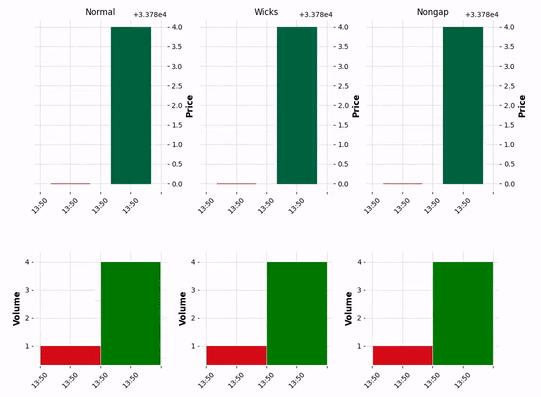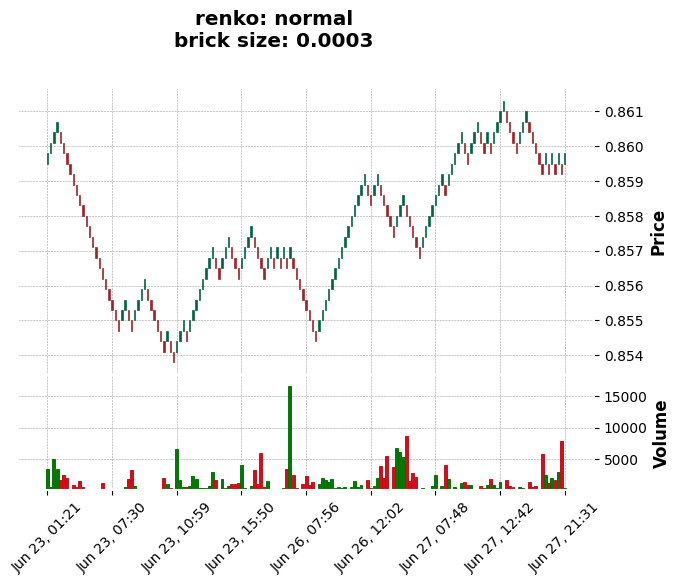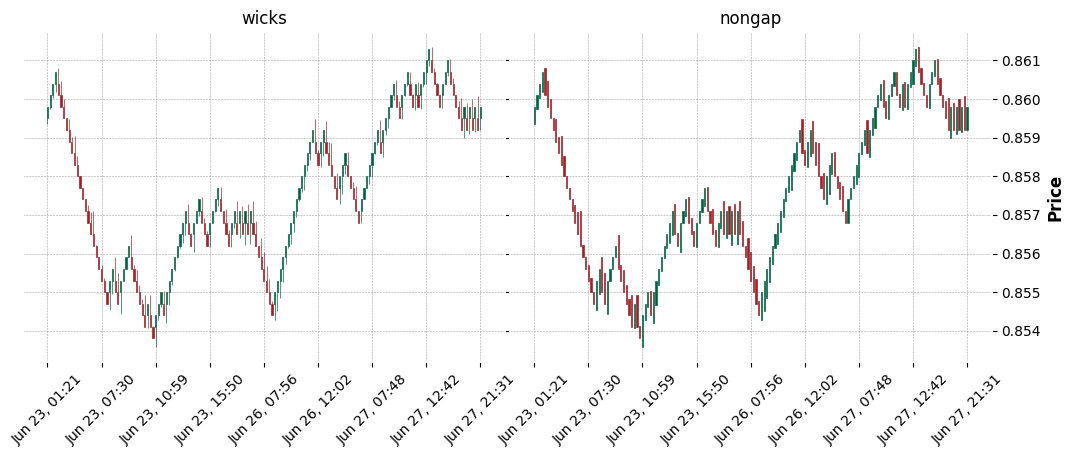Transform Tick Data into OHLCV Renko Dataframe!
Project description
renkodf
Transform Tick Data into OHLCV Renko Dataframe!
Installation
pip install renkodf
or just copy renkodf.py file to your project!
- renkodf requires pandas, numpy and mplfinance
Content
Usage
There are two classes available:
Renko(df, brick_size, add_columns)
To create Renko OHLCV dataframe with existing Ticks data.RenkoWS(timestamp, price, brick_size, external_df, external_mode)
To create real-time Renko charts, usually over a WebSocket connection.
Let's start with the first class, load a Pandas DataFrame containing Ticks Data, for example:
import pandas as pd
df_ticks = pd.read_parquet('examples/data/EURGBP_T1_cT.parquet')
df_ticks.rename(columns={'bid': 'close'}, inplace=True)
df_ticks.head(3)
df_ticks.tail(3)
| ask | close | spread | |
|---|---|---|---|
| datetime | |||
| 2023-06-23 00:00:00.335 | 0.85950 | 0.85945 | 0.00005 |
| 2023-06-23 00:00:00.541 | 0.85951 | 0.85944 | 0.00007 |
| 2023-06-23 00:00:02.106 | 0.85950 | 0.85944 | 0.00006 |
| ask | close | spread | |
|---|---|---|---|
| datetime | |||
| 2023-06-27 23:59:56.612 | 0.85976 | 0.85969 | 0.00007 |
| 2023-06-27 23:59:57.175 | 0.85975 | 0.85969 | 0.00006 |
| 2023-06-27 23:59:59.053 | 0.85974 | 0.85969 | 0.00005 |
Only two columns are required:
close: Mandatory.datetime: If is not present, the index will be used.
You can add other columns if you want, just put a list with their names in theadd_columnsparameter.
After importing renkodf and setting brick_size, just call renko_df() with the chosen mode name.
See all available modes in renkodf_modes.ipynb
from renkodf import Renko
r = Renko(df_ticks, brick_size=0.0003)
df = r.renko_df('normal') # 'wicks' = default
df.head(3)
df.tail(3)
100.0%
| open | high | low | close | volume | |
|---|---|---|---|---|---|
| datetime | |||||
| 2023-06-23 01:21:58.333 | 0.8595 | 0.8598 | 0.8595 | 0.8598 | 3458.0 |
| 2023-06-23 01:33:24.996 | 0.8598 | 0.8601 | 0.8598 | 0.8601 | 571.0 |
| 2023-06-23 03:18:30.345 | 0.8601 | 0.8604 | 0.8601 | 0.8604 | 4993.0 |
| open | high | low | close | volume | |
|---|---|---|---|---|---|
| datetime | |||||
| 2023-06-27 17:29:15.119 | 0.8595 | 0.8598 | 0.8595 | 0.8598 | 2889.0 |
| 2023-06-27 21:01:00.071 | 0.8595 | 0.8595 | 0.8592 | 0.8592 | 7779.0 |
| 2023-06-27 21:31:48.569 | 0.8595 | 0.8598 | 0.8595 | 0.8598 | 359.0 |
You can use mpf.plot() or r.plot(), as in the example below.
import mplfinance as mpf
mpf.plot(df, type='candle', volume=True, style="charles",
title=f"renko: normal\nbrick size: 0.0003")
mpf.show()
# same as:
# r.plot('normal')
As described in renkodf_modes.ipynb, we can have multiple dataframes of different modes from the same instance.
df_wicks = r.renko_df('wicks')
df_nongap = r.renko_df('nongap')
fig = mpf.figure(style='charles', figsize=(12.5,9))
fig.subplots_adjust(hspace=0.1, wspace=0.01)
ax1 = fig.add_subplot(2,2,1)
ax2 = fig.add_subplot(2,2,2)
mpf.plot(df_wicks,type='candle',ax=ax1,axtitle='wicks', )
mpf.plot(df_nongap,type='candle',ax=ax2,axtitle='nongap')
mpf.show()
Animation/Real-time Renko Chart
Following the steps of the mplfinance documentation, it can be tricky to display animations properly in jupyter notebooks, therefore, to keep things simple, the animation examples are scripts.
To run the animation examples, clone this repository, then into the renkodf/examples folder, run:
- python ws_animchart_demo.py
- python ws_multichart_demo.py
- python ws_externaldf_demo.py
NOTE: There are comments, in each of the above example files, talking about situations or recommendations to be applied in real cases.
Is the Renko chart calculated correctly?
I also asked myself the same question, how about we see for ourselves?
We are going to do this based on Spotware's FX/CFD Trading Platform called cTrader,
using IC Markets as a Price Provider.
Let's go!
RESUME: Despite the possible occurrence of more/less bricks, the renko calculation used is practically the same, or very approximate.
Non-Affiliation Disclaimer
I'm not endorsed by, directly affiliated with, maintained, authorized, or sponsored by any company previously mentioned.
All product and company names are the registered trademarks of their original owners.
The use of any trade name or trademark is for identification and reference purposes only and does not imply any association with the trademark holder of their product brand.
Project details
Release history Release notifications | RSS feed
Download files
Download the file for your platform. If you're not sure which to choose, learn more about installing packages.














